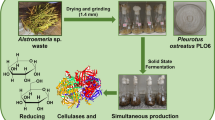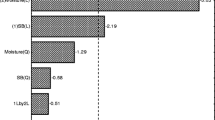Abstract
A comparison of different habitats, biogas plant, rumen fluid and sewage sludge, for cellulolytic organisms indicated sewage studge was the best source. Enrichment cultura gave a mixed culture which exhibited CMCase activity as well as extracellular Avicelase, xylanase, β-glucosidase, β-xylosidase activities and cell-bound β-glucosidase, and β-xylosidase production in a synthetic medium with eleven different cellulosic and lignocellulosic substrates. The activity of extracellular β-glucosidase and β-xylosidase production was significantly higher than endogenous activities. Hemicellulases were induced better than cellulases. The anzyme system was stable under aerobic conditions. Of the different lignocellulosic substrates, kallar grass was the best inducer of extracellular enzymes.
Résumé
La comparaison de différents habitats: digesteur méthanique, fluide du rumen ou boue de station d'épuration, pour leur contenu en organismes cellulolytiques, indiquent que la boue de station d'épuration est la meilleure source. Une culture par enrichissement a produit une culture mixte qui a exhibé aussi bien une activité CMCase que des activitiés extracellulaires avicelasique, xylanasique, β-glucosidasique et β-xylosidasique et qu'une production de β-glucosidase et de β-xylosidase liées à la cellule, dans un milieu synthétique et pour onze substrats cellulosiques et lignocellulosiques différents. L'activité de la β-glucosidase extracellulaire et la production de β-xylosidase sont significativement plus élevées que les activitiés endogènes. Les hemicellulases sont mieux induites que les cellulases. Le système enzymatique est stable dans des conditions aérobies. Parmi les divers substrats lignocellulosiques, l'herbe Kallar est le meilleur inducteur d'enzymes extracellufaires.
Similar content being viewed by others
References
Feldman, K.A., Lovett, J.S. &Tsao, G.T. 1988 Isolation of cellulase enzymes from the thermophlic fungusThermanoascus aurantiacus and regulation of enzyme production.Enzyme and Microbial Technology. 10, 262–272.
Gharpuray, M.M., Lee, Y.H. &Fan, L.T. 1983 Structural modification of lignocellulosic substrates by pretreatments to enhance enzymatic hydrolysis.Biotechnology and Bioengineering 25, 419.
Ghose, T.K. &Bisaria, V.S. 1979 Studies on the mechanism of enzymatic hydrolysis of cellulosic substances.Biotechnology and Bioengineering 21, 131–146.
Hungate, R.E. 1950 The anaerobic mesophilic cellulolytic bacteria.Bacteriological Reviews 14, 1–49.
Khan A.W. 1977 Anaerobic degradation of cellulose by mixed culture.Canadian Journal of Microbiology 23, 1700–1705.
Khan, A.W., Trottier, T.M., Patel, G.B. &Martin, S.M. 1979 Nutrient requirement for the degradation of cellulose to methane by a mixed population of anaerobes.Journal of General Microbiology 112, 365–372.
Khan, A.W., Wall, D. &Berg, L.V.D. 1981 Fermentative conversion of cellulose to acetic acid and cellulolytic enzyme production by a bacterial mixed culture obtained from sewage sludge.Applied and Environmental Microbiology 41, 1214–1218.
Khan, A.W. &Murray, W.D. 1982 Single step conversion of cellulose to ethanol by a mesophilic coculture.Biotechnology Letters 7, 47–50.
Langsford, M.L., Gilkes, N.R., Wakarchuk, W.W., Kilbiurn, D.G., Miller Jr. R.C. &Warren, R.A.J. 1984 The cellulase system ofCellulomonas fimi:Journal of General Microbiology 130, 1367–1376.
Lee, S.F., Forsberg, C.W. &Gibbins, L.N. 1985 Cellulolytic activity ofCl. acetobutylicum.Applied and Environmental Microbiology 50, 220–228.
Malik, K.A., Aslam, Z. &Naqvi, M. 1986 Kallar grass a plant for saline land. Faisalabad: Nuclear Institute for Agriculture and Biology.
Miller, G.L. 1959 Use of dinitrosalicylic and reagent for the determination of reducing sugars.Analytical Chemistry 31, 426–428.
Patel, G.B., Khan, A.W., Agnew, B.J. &Colvin, J.R. 1980 Isolation and characterization of an anaerobic, cellulolytic microorganism,Acetovibrio cellulolyticus nov. gen; nov. sp. International Journal of Systematic Bacteriology 30, 179–185.
Rajoka, M.I. &Malik, K.A. 1984 Cellulase and hemicellulase production byCellulomonas flavigena NIAB-441.Biotechnology Letters 6, 597–600.
Richard, P.A.D., Rajoka, M.I. &Ide, J.A. 1981 The glycodidases ofCellulomonas.Biotechnology Letters 3, 487–492.
Weimer, P.J. &Zeikus, J.G. 1977 Fermentation of cellulose and cellobiose byClostridium thermocellum in the absence and presence ofMethanobacterium thermoautotrophicum.Applied and Environmental Microbiology 33, 289–297.
Wilke, C.R., Stockar, U.V. &Yang, R.D. 1976 Process design basis for enzymatic hydrolysis of cellulosic newsprint.AIChE Symposium Series72, p. 104.
Author information
Authors and Affiliations
Rights and permissions
About this article
Cite this article
Tabassum, R., Rajoka, M.I. & Malik, K.A. Production of cellulases and hemicellulases by an anaerobic mixed culture from lignocellulosic biomass. World J Microbiol Biotechnol 6, 39–45 (1990). https://doi.org/10.1007/BF01225353
Received:
Accepted:
Issue Date:
DOI: https://doi.org/10.1007/BF01225353




